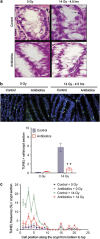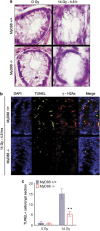Suppression of radiation-induced DNA double-strand break repair by MyD88 is accompanied by apoptosis and crypt loss in mouse colon
- PMID: 23939014
- PMCID: PMC3759122
- DOI: 10.1038/oncsis.2013.22
Suppression of radiation-induced DNA double-strand break repair by MyD88 is accompanied by apoptosis and crypt loss in mouse colon
Abstract
Intestinal microbes promote the injurious effects of radiation on those tissues. However, the molecular factors mediating this effect are largely unknown. In this work, we explored the effects of orally administered antibiotics and MyD88, a key adapter molecule in toll-like receptor signaling, on molecular and cellular responses of mouse colon to radiation. Results show that oral antibiotics lowered radiation-induced colonic damage by protecting epithelial cells against radiation-induced apoptosis, leading to increased survival of crypts. MyD88 deficiency partially phenocopied the effects of oral antibiotics on apoptosis and crypt survival, suggesting that colonic microbes exert their injurious effects in part via that molecule. Analysis of DNA double-strand breaks, the primary genotoxic lesions induced by radiation, showed that their early induction in mouse colon was unaffected by MyD88. However, MyD88 deficiency resulted in the later disappearance of DNA double-strand breaks. Loss of DNA double-strand breaks was accompanied by the evidence of increased activation of both the non-homologous end-joining and homologous recombination pathways of DNA repair in MyD88-deficient mice. These results show that colonic microbes and MyD88 regulate DNA double-strand break repair in irradiated mouse colon, effects which exert significant control over radiation-induced apoptosis and crypt survival.
Figures






Similar articles
-
NHEJ Contributes to the Fast Repair of Radiation-induced DNA Double-strand Breaks at Late Prophase I Telomeres.Health Phys. 2018 Jul;115(1):102-107. doi: 10.1097/HP.0000000000000852. Health Phys. 2018. PMID: 29787435
-
Impairment of the non-homologous end joining and homologous recombination pathways of DNA double strand break repair: Impact on spontaneous and radiation-induced mammary and intestinal tumour risk in Apc min/+ mice.DNA Repair (Amst). 2015 Nov;35:19-26. doi: 10.1016/j.dnarep.2015.08.002. Epub 2015 Sep 6. DNA Repair (Amst). 2015. PMID: 26435054
-
Extensive ssDNA end formation at DNA double-strand breaks in non-homologous end-joining deficient cells during the S phase.BMC Mol Biol. 2007 Oct 26;8:97. doi: 10.1186/1471-2199-8-97. BMC Mol Biol. 2007. PMID: 17963495 Free PMC article.
-
Aberrant DNA Double-strand Break Repair Threads in Breast Carcinoma: Orchestrating Genomic Insult Survival.J Cancer Prev. 2016 Dec;21(4):227-234. doi: 10.15430/JCP.2016.21.4.227. Epub 2016 Dec 30. J Cancer Prev. 2016. PMID: 28053956 Free PMC article. Review.
-
[Double strand break repair, one mechanism can hide another: alternative non-homologous end joining].Cancer Radiother. 2012 Feb;16(1):1-10. doi: 10.1016/j.canrad.2011.05.004. Epub 2011 Jul 6. Cancer Radiother. 2012. PMID: 21737335 Review. French.
Cited by
-
The intestinal microbiota in allogeneic hematopoietic cell transplant and graft-versus-host disease.Blood. 2017 Feb 23;129(8):927-933. doi: 10.1182/blood-2016-09-691394. Epub 2016 Dec 9. Blood. 2017. PMID: 27940475 Free PMC article. Review.
-
Sam68/KHDRBS1-dependent NF-κB activation confers radioprotection to the colon epithelium in γ-irradiated mice.Elife. 2016 Dec 20;5:e21957. doi: 10.7554/eLife.21957. Elife. 2016. PMID: 27996939 Free PMC article.
-
Hydrogen-water ameliorates radiation-induced gastrointestinal toxicity via MyD88's effects on the gut microbiota.Exp Mol Med. 2018 Jan 26;50(1):e433. doi: 10.1038/emm.2017.246. Exp Mol Med. 2018. PMID: 29371696 Free PMC article.
-
Pattern recognition receptors and DNA repair: starting to put a jigsaw puzzle together.Front Immunol. 2014 Jul 23;5:343. doi: 10.3389/fimmu.2014.00343. eCollection 2014. Front Immunol. 2014. PMID: 25101085 Free PMC article. Review. No abstract available.
-
Radiation takes its Toll.Cancer Lett. 2015 Nov 28;368(2):238-45. doi: 10.1016/j.canlet.2015.03.031. Epub 2015 Mar 25. Cancer Lett. 2015. PMID: 25819030 Free PMC article. Review.
References
-
- Potten CS. A comprehensive study of the radiobiological response of the murine (BDF1) small intestine. Int J Radiat Biol. 1990;58:925–973. - PubMed
-
- Withers HR, Elkind MM. Microcolony survival assay for cells of mouse intestinal mucosa exposed to radiation. Int J Radiat Biol Relat Stud Phys Chem Med. 1970;17:261–267. - PubMed
LinkOut - more resources
Full Text Sources
Other Literature Sources

